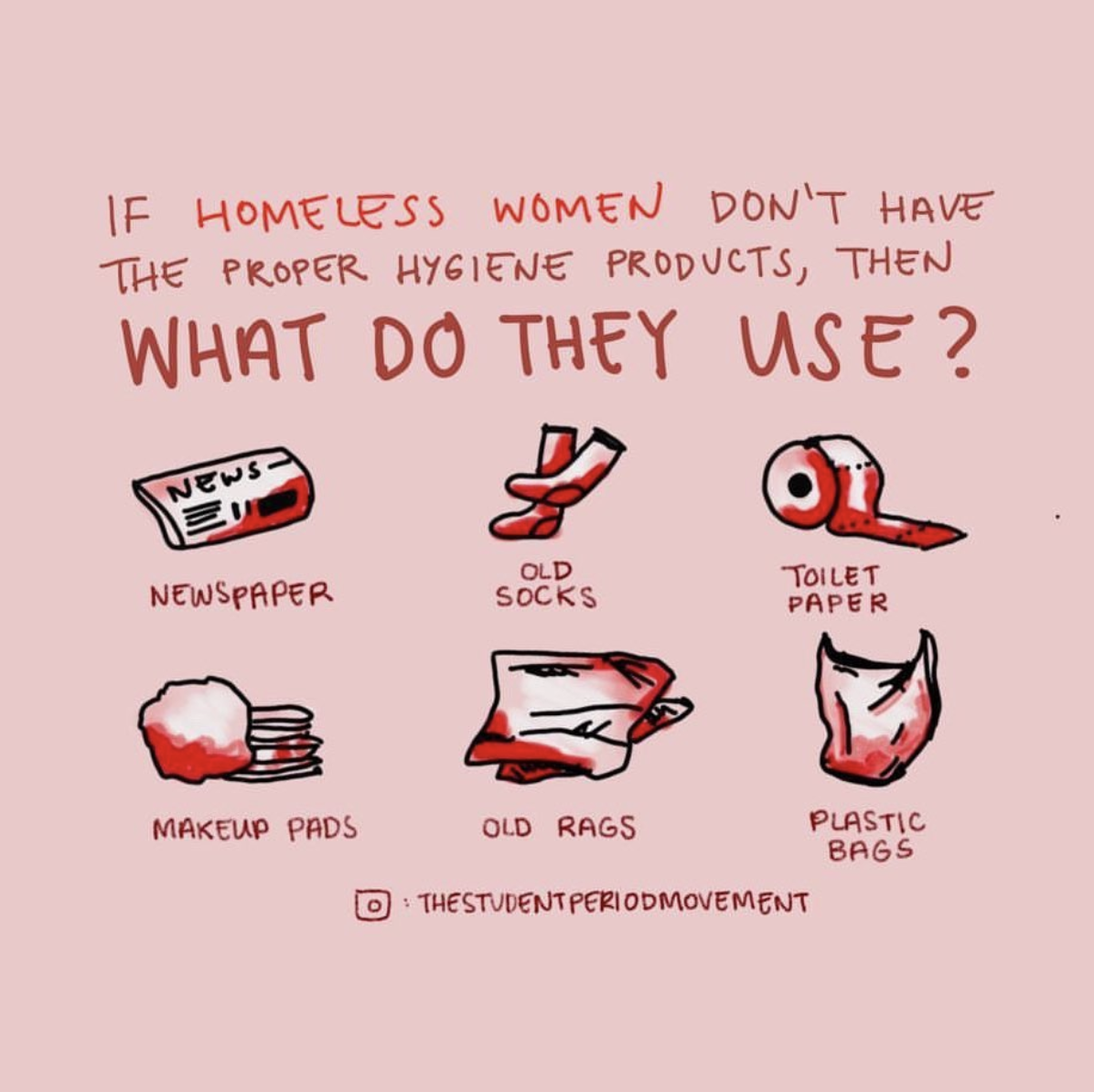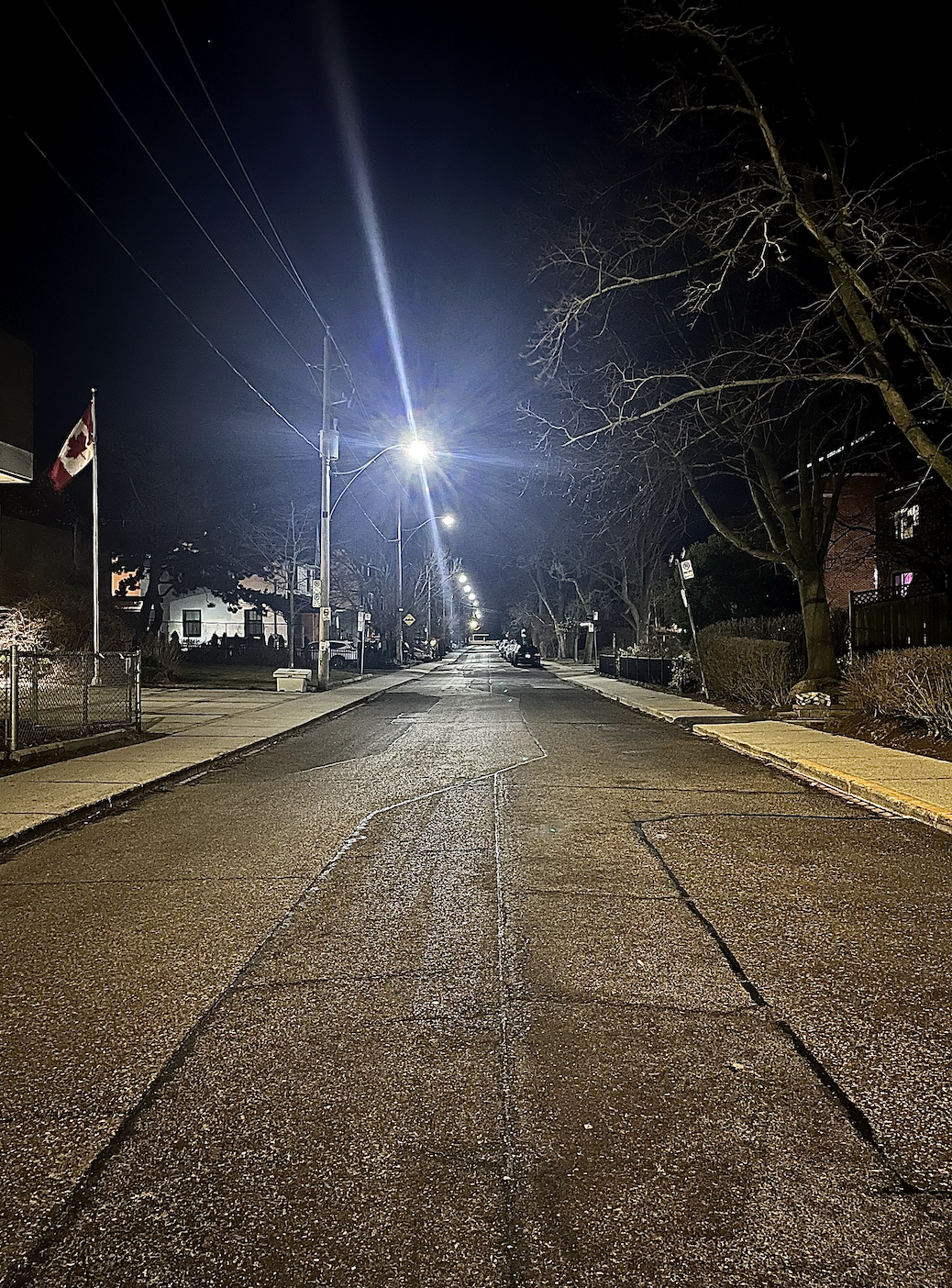Sleeping Rough: A Gendered Reality
In Canada, homelessness is defined as the situation of an individual without stable, safe, permanent, and appropriate housing, or the immediate prospect of acquiring it. ‘Rough sleeping’ is the most visible type of homelessness - it refers to when people do not have access to physical shelter of their own and resort to sleeping in public spaces (such as in doorways or on the sidewalk) and places not intended for human habitation (such as cars or tents). Photo Credit: D. O’Reilly
Introduction
Navigating day-to-day life presents significant challenges for all unhoused people who often struggle to acquire food, shelter, and other basic resources. But for unsheltered women, there can be additional – and compounding – gender-related layers of hardship in their daily routine. From managing menstrual cycles, to evading gender-based violence, and coping with pregnancy – gender plays a heavy hand in the experience of women who sleep rough. Periods
Menstruation is one example of a gender specific problem that women who sleep rough have to deal with. Periods don’t stop when you’re homeless and they can add an additional, largely unavoidable, and frequently occurring complexity to a woman's experience of homelessness. Period Products
Periods are bloody expensive. Menstruation products can be pricey for many Canadians and they are an additional and specific cost, borne (almost exclusively) by women. Trying to budget upwards of $20 every month for tampons or pads can be prohibitive for unsheltered women who are already facing extreme financial strain. Some women turn to makeshift solutions to deal with their periods such as wadded up tissue paper, cotton balls, and socks. However, using improvised menstrual products can result in negative health implications. Common risks include vaginal cuts, chemical irritation and yeast infections, but more serious cases can result in life threatening conditions like toxic shock syndrome. With limited financial and material resources, many unsheltered women ‘make do’ during their period. Image Credit: The Student Period Movement
Appropriate Facilities for Menstrual Management
If and when they are able to acquire menstrual products, unsheltered women then need to regularly find a secure and private space to change them. A shortage of public washrooms negatively affects all women but women who sleep rough are doubly disadvantaged, as the alternative - privately owned but publicly available facilities (like those in cafes) - can be a hostile environment for these individuals. The ability to care for oneself during menstruation can be further hindered by unsheltered women’s precarious access to other sanitation resources, such as laundry and shower facilities. There is a lack of quality public washrooms in Canada cities. Some are only open seasonally or at certain times of day. Many cost money to use. In almost all Canadian cities public toilet facilities are scarce. This can be a significant issue for unsheltered women, particularly when they are on their period and have nowhere else to go. Photo Credit: D. O’Reilly
Proactive Period Policies
Period management is an important health issue. Lack of access to menstruation products and related facilities – such as washrooms, showers, and laundry – can result in poor sanitation, social stigmatisation, and problematic health outcomes.Yet, menstruation has historically been overlooked in policies addressing healthcare for homeless and unsheltered individuals. Recently this has started to change. Advocacy groups and not-for-profit organisations, such as Edmonton’s No Period Without, are pushing for greater access to menstrual products for women in need. And in 2023 the Government of Canada, in association with Food Banks Canada, announced a Menstrual Equity Fund Pilot aimed at combating period poverty across the country.Gender Based Violence
The threat of gender-based violence (GBV) is another ever-present hardship that disproportionately affects unsheltered women compared to their male counterparts. ‘Easy Targets’
In Canada, homeless women and girls experience high levels of physical and sexual violence; a harrowing one-third of women reported experiencing major violence whilst homeless. Women who sleep rough or are residing in shelters are particularly susceptible to being targets of GBV. Without access to private, safe, and stable shelter, these women often fend for themselves on the street – frequently alone, and at night – and can be viewed as exposed and vulnerable. Perpetrators of violence against unsheltered women are, primarily, male and research suggests that some men can ‘interpret women’s homelessness as a licence for abuse’A safe place to sleep? Women who sleep rough spend a significant amount of time in public space, including during times of day when there are limited ‘eyes on the street’. This exposes unsheltered women to an increased risk of gender-related violent crimes. Photo Credit: D. O’Reilly
Daily Threats
The risks that unsheltered women face whilst sleeping rough are serious and they can exact a high psychological and physical toll. These risks range from being subjected to unwanted sexual attention and threats, to being physically and sexually assaulted, raped, or exploited via human trafficking. For a variety of reasons – including discrimination, fear of re-victimisation, and lack of trust in the system – many of these violent encounters are not formally reported.Safe Shelters for Women
Whilst seeking refuge in the shelter system may appear to be a rational strategy to combat the dangers of sleeping ‘on the street,’ shelters are not always safe havens for women. Many shelters are co-ed and research consistently shows that many women avoid co-ed shelters out of fear of, or past experience of, violence within these spaces. In Canada, shelter facilities that are geared specifically towards women are limited, especially in northern , rural, and remote communities. Where they do exist, women-specific shelters and shelter beds are often at (or over) capacity . Because of this, and despite their profound need, many unsheltered women are turned away from these facilities each day. Women may not go to men’s or co-ed shelters due to fear of and experiences of violence and sexual assault. Photo Credit: The State of Women’s Housing Need & Homelessness in Canada, Executive Summary
The Complex Relationship between Unhoused Women & Violence
The relationship between women, gender-based violence, and homelessness is a complex issue. Violence is often a cyclical experience for unsheltered women, as violence both shapes women's pathways into homelessness and also exists as a prevalent lived-experience whilst sleeping rough. An unsheltered woman's social location can also have a significant impact on her likelihood of experiencing GBV. In Canada certain subgroups of women – including young women and girls, Indigenous women, and members of the LGBTQ+ community – are particularly susceptible to being affected by violent crime whilst homeless.
In the confines of this article, It is not possible to provide a comprehensive overview of the multitude of intersections between women experiencing homelessness and the experience of gender based violence. Those looking to do a deeper dive into the issue should explore the resources available through Canada’s Women's National Housing and Homeless Network. Pregnancy
Pregnancy is not a part of every unsheltered woman’s experience of homelessness. However, approximately 50% of homeless women get pregnant, many within the first 12 months of becoming homeless. For unsheltered women who become pregnant, the experience can be extremely challenging – regardless if the pregnancy is wanted, or not. Unwanted Pregnancy
Bringing a child into the world whilst experiencing extreme housing precarity is something that many women seek to avoid. While contraception can be used by unsheltered women to prevent pregnancy, it can be costly and difficult to obtain. Many contraceptive methods can be financially out of reach for individuals sleeping rough – especially since, unlike the U.K. and the U.S.A, there is no universal subsidy for contraception in Canada. Abortion is legal in Canada and the federal government states that ‘everyone should have access to safe and consistent reproductive health services, including abortion.’ However, unsheltered women seeking to terminate an unplanned pregnancy can encounter numerous barriers to accessing abortion services including a lack of local clinics (and subsequent costs related to travel and accommodation), lack of information about available services, and difficulties retaining official personal documentation. Stigma
Although being pregnant whilst homeless may come with significant challenges, this does not mean that all pregnancies experienced by unsheltered women are unwanted. Many women view expectant motherhood positively, and this can include those who sleep rough. However, studies consistently show that unsheltered women who are pregnant are regularly the subject of stigma, including preconceptions about laziness, addiction, and mental illness. Being subjected to negative stereotypes can further perpetuate the marginalisation and exclusion of unsheltered pregnant women.Prenatal Health
For those unsheltered women who continue their pregnancy, there are day-to-day challenges in managing prenatal health with rough sleeping. Unsheltered women frequently have compromised levels of physical and mental health. This is understandable. It can be difficult or impossible to prioritise exercise, a balanced diet, and adequate sleep when you don’t have a roof over your head; and sleeping rough can also trigger extended periods of extreme stress. If not addressed, these adverse conditions can result in poor health outcomes for the woman’s fetus, including delayed neurobiological development, low birth weight, and an increased risk of pregnancy loss. Getting professional prenatal care can help identify and address potential pregnancy complications for mothers sleeping rough. Programs, such as Toronto’s HARP team, are designed to provide unsheltered women with the support, resources, and information that they need throughout their pregnancy. Unsheltered women often do not access reproductive and prenatal care programs, with reasons ranging from a lack of awareness,to financial barriers, to a fear of stigma. Image Credit: YMCA Hamilton
Conclusion
Periods. Violence. Pregnancy. Discrimination. These gender-related complexities compound the day-to-day challenges faced by unsheltered women.
A large part of the problem is access. Access to menstrual products. Access to washrooms. Access to trauma-informed shelters and shelter beds. Access to contraception. Access to reproductive education and services.
Resources and services that address the unique needs of women sleeping rough are frequently overlooked and underfunded. Going forward, things have to change. If we are to improve the circumstances and outcomes for women and girls currently (or at risk of) experiencing homelessness, a gender-specific lens is needed.
Resources
Women & Girls’ Homelessness in CanadaBest Practice Guideline for Ending Women’s and Girl’s HomelessnessThe Pan-Canadian Women’s Housing & Homelessness SurveyWomen’s homelessness: hidden in plain sightHomelessness Statistics In Canada.What is Homelessness?Homelessness in Canada has reached a humanitarian crisis level, experts warnHomelessness in CanadaA review of Canadian homelessness data, 2023Characterizing people experiencing homelessness and trends in homelessness using population-level emergency department visit data in Ontario, CanadaFemale Homelessness and Period PovertyGetting Your Period Can Be a Pain. Getting It While Homeless Is Even WorsePeriod Poverty in Plain Sight.Why Public Washrooms aren’t Working for WomenA New Horizon – The Pan-Canadian Women’s Housing and Homelessness SurveyNo More Taboo: The experiences of menstruation by homeless women: a preliminary reportA Gender Lens on Homelessness: Lessons from YWCA TorontoThe Street Health Report 2007Homelessness, Victimization and Crime: Knowledge and Actionable RecommendationsPublic restrooms, periods, and people experiencing homelessness: An assessment of public toilets in high needs areas of Manhattan, New YorkHousing, Homelessness, and Violence Against Women: A discussion paperJust Launched! Federal Housing Advocate’s Interim Report Highlights Gendered Experiences in EncampmentsAbout Homelessness: Single Women.Canadian Definition of HomelessnessAbout Homelessness: Hidden HomelessnessInsights on Canadian Society Hidden homelessness in CanadaHomelessness is a woman’s world, too, but a very hidden one, study showsRecognizing and responding to women experiencing homelessness with gendered and trauma-informed careThe State of Women’s Housing Need & Homelessness in Canada: Literature ReviewReclaiming Power and Place: The Final Report of the National Inquiry into Missing and Murdered Indigenous Women and Girls, Volume 1aHousing Needs & Homelessness Amongst Gender-Diverse People in CanadaGuide for developing effective gender-responsive support and solutions for women experiencing homelessnessThe Facts about the Gender Pay GapACLU: Domestic Violence and HomelessnessIs it OK to use the word ‘homeless’ – or should you say ‘unhoused’?Periods an extra hardship for homeless womenNo More Taboo: Breaking taboos around menstruation and sanitationWhat It's Like to Get Your Period When You're HomelessDefining and Enumerating Homelessness in Canada .96 per cent of homeless women experience some type of violenceAbout Homelessness: Lesbian, Gay, Bisexual, Transgender, Transsexual, Queer, Questioning and Two-Spirit (LGBTQ2S)Street youth are among the most victimized population in CanadaAboriginal Homelessness in CanadaGender-Based Violence and Homelessness: Two Sides of the Same CoinHundreds of babies are born into homelessness in Toronto each year, even under COVID-19. Their mothers scramble to find them a safe place to live — in city shelters or a friend’s apartmentHomelessness, reproductive health & pregnancyPregnancy and Mental Health of Young Homeless WomenEffects of prenatal stress on pregnancy and human development: mechanisms and pathwaysHomeless and pregnant in Toronto: How to get helpHomeless And Pregnant: Toronto Program Aims To Educate Homeless WomenPeriod PovertyMenstrual products neglected when addressing poverty, organizer says as drive collects 11,000 pads, tamponsThe Hidden Cost of Periods: A Canadian PerspectiveAbortion is legal in Canada -- but is it accessible? Experts weigh inGetting Your Period Can Be a Pain. Getting It While Homeless Is Even WorseEmpowering Homeless Pregnant Women: Shattering Stereotypes and Building SupportAbout Homelessness: Sexual/Reproductive Care.Government of Canada Strengthens Access to Abortion ServicesGovernment of Canada Strengthens Access to Abortion ServicesEffects of prenatal stress on pregnancy and human development: mechanisms and pathwaysHomelessness Contributes To Pregnancy ComplicationsWomen sleeping rough: The health, social and economic costs of homelessnessYWCA Hamilton advocates for Reproductive Care for unhoused community members at the 10th Women’s Health Days with Greater Hamilton Health NetworkPeriod equity: What it is and why it matters.How Long Can You Safely Leave a Tampon in For?Youth Activism: We Are on a Mission to End Period PovertyPeriod Poverty Affects Transgender and Gender Non-Conforming People, Too







